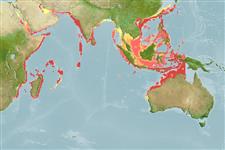Environment: milieu / Zona climática / intervalo de profundidade / distribution range
Ecologia
marinhas associadas(os) a recifes; intervalo de profundidade 1 - 110 m (Ref. 89707). Tropical; 30°N - 27°S, 33°E - 136°E
Indian Ocean: Persian Gulf to southern Mozambique and eastward to Western Australia. Not known from the Red Sea.
Comprimento de primeira maturação / Tamanho / Peso / Idade
Maturidade: Lm ? range ? - 50 cm
Max length : 100.0 cm TL macho/indeterminado; (Ref. 5222); common length : 75.0 cm TL macho/indeterminado; (Ref. 5450); peso máx. publicado: 9.0 kg (Ref. 3132)
Espinhos dorsais (total) : 11; Raios dorsais (total) : 15 - 17; Espinhos anais: 3; Raios anais : 8. Distinguished by the following characteristics: color is dark purplish gray with scattered irregular whitish spots and blotches which are faint or absent in preserved fish; ctenoid body scales except cycloid dorsoanteriorly below anterior half of spinous dorsal fin, thorax, abdomen and above anterior anal fin; body with numerous auxiliary scales; greatest depth of body 2.5-3.0 in SL; slightly emarginate to truncate caudal fin; short pelvic fins, 1.7-2.3 in head length (Ref. 90102); head length 2.4-2.7 times in SL; distinctly convex interorbital, slightly convex dorsal head profile; subangular preopercle, shallow notch just above the angle, serrae at angle not or slightly enlarged; upper edge of operculum straight; posterior nostrils of adults is twice the size of anterior nostrils; maxilla reaches vertical at rear edge of eye or thereabouts; ventral edge of maxilla of adults with distinct step distally; 2 rows of teeth on midlateral part of lower jaw (Ref. 89707).
Body shape (shape guide): fusiform / normal; Cross section: oval.
Inhabit clear to turbid water in shallow as well as deep water (Ref. 4787). Juveniles are found in inshore coral reefs (Ref. 5222). They feed in water to more than 100 m depth (Ref. 27275). It has been suggested that juveniles mimic the herbivorous damselfish Neopomacentrus sindensis, presumably to get closer to their unsuspecting prey (Ref. 5222, 9710). Feed on small fishes and crabs. Probably spawn during restricted periods and form aggregations when doing so (Ref. 27352). Eggs and early larvae are probably pelagic (Ref. 6390). Solitary (Ref 90102).
Ciclo de vida ou comportamento de acasalamento
Maturidade | Reprodução | Desova | Ovos | Fecundidade | Larvas
Rock cod are protogynous hermaphrodites.
Heemstra, P.C. and J.E. Randall, 1993. FAO Species Catalogue. Vol. 16. Groupers of the world (family Serranidae, subfamily Epinephelinae). An annotated and illustrated catalogue of the grouper, rockcod, hind, coral grouper and lyretail species known to date. Rome: FAO. FAO Fish. Synop. 125(16):382 p. (Ref. 5222)
Status na Lista Vermelha da UICN (Ref. 130435: Version 2025-1)
Ameaça para os humanos
Harmless
Uso pelos humanos
Pescarias: espécies comerciais
Ferramentas
Relatórios especiais
Baixar XML
Fontes da internet
Estimates based on models
Preferred temperature (Ref.
123201): 24.7 - 29.2, mean 27.3 °C (based on 386 cells).
Índice de diversidade filogenética (Ref.
82804): PD
50 = 0.5000 [Uniqueness, from 0.5 = low to 2.0 = high].
Bayesian length-weight: a=0.00977 (0.00574 - 0.01664), b=3.00 (2.86 - 3.14), in cm total length, based on LWR estimates for this species & Genus-body shape (Ref.
93245).
Nível Trófico (Ref.
69278): 3.9 ±0.66 se; based on food items.
Generation time: 4.1 ( na - na) years. Estimated as median ln(3)/K based on 2
growth studies.
Resiliência (Ref.
120179): médio(a), tempo mínimo de duplicação da população 1,4 - 4,4 anos (K=0.27).
Prior r = 0.57, 95% CL = 0.37 - 0.85, Based on 1 data-limited stock assessment.
Fishing Vulnerability (Ref.
59153): Moderate vulnerability (39 of 100).
🛈
Climate Vulnerability (Ref.
125649): Very high vulnerability (82 of 100).
🛈
Nutrients (Ref.
124155): Calcium = 19.7 [9.8, 42.9] mg/100g; Iron = 0.456 [0.240, 0.931] mg/100g; Protein = 18.7 [17.2, 20.1] %; Omega3 = 0.12 [0.07, 0.19] g/100g; Selenium = 48.1 [27.5, 89.1] μg/100g; VitaminA = 106 [30, 362] μg/100g; Zinc = 1.01 [0.71, 1.45] mg/100g (wet weight);
